Lombok
Lombok: A less-touristed Alternative to Bali
Date Visited: May 2021
Getting There
Lombok can be reached in under an hour from Bali’s Denpasar airport. There is also regular ferry service between the two islands. There are dozens of flights daily from Jakarta and most other major airports in the archipelago and, outside of holiday seasons, round trips are reasonably priced.
Lombok is a fairly large island, located directly east of Bali. Geographically it’s a cousin of Bali and has many of the same attributes, but it is significantly different culturally than Hindu-majority Bali in that it is Islam and, therefore, doesn’t share its more-famous cousin’s easy-going spirit. There is tourism in Lombok, but much of it is domestic, and certainly some of the rowdy excess one might witness in Bali is frowned upon here (except on Gili Trawangan which I will discuss later). Lombok has pleasant beaches, snorkeling, rugged mountainous scenery, and lush tropical forests like Bali, without as much tourist chaos.
Senggigi vs Kuta Lombok

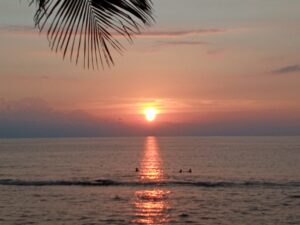
The long stretch of beach at Senggigi on the island’s northwest coast was the first area of Lombok to experience tourist development. It’s where I chose to stay. I picked Senggigi because of its variety of lodging options and its proximity to the Gili Islands and to access some natural features of Lombok I wanted to see. If you wish to explore Mt. Rinjani (usually a two-day excursion), Senggigi is also a great home base. Surfers and beach enthusiasts might consider staying at the up-and-coming Kuta Lombok region on the southern tip of the island where the famous Pink Beach is also located. According to some, Kuta Lombok is rapidly becoming “the next Bali” as a dynamic destination. Whether that’s a plus or not depends on your preferences.
Sedang Gile and Tiu Kelep
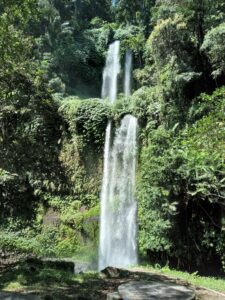
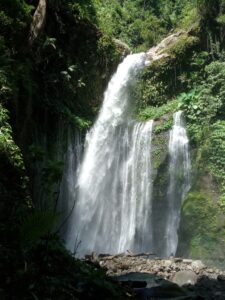
Waterfall enthusiasts will love these two amazing cascades on the northern part of the island located in the foothills of Mt. Rinjani. From the parking lot, it’s a gentle 15-minute hike through a verdant forest inhabited by grey macaques until you reach the first waterfall, Sedang Gile. It’s a two-tier waterfall about 30 m. high. If you bring swimming attire, you can frolic underneath the falls. There are also several food and souvenir stands from which you can purchase items.
It takes an additional 30 to 40-minute hike to reach the second waterfall, Tiu Kelep. This second trail is rugged and has difficult terrain. In addition, there are a couple of places where you will have to wade across the river, which is a bit treacherous. If you have sufficient stamina and nimbleness, it is manageable, but it isn’t an excursion for grandma and grandpa: you can leave them at Sedang Gile for a couple hours. The arduous trek is worth it because Tiu Kelep is one of the most beautiful waterfalls I’ve ever seen. It’s about 40 meters high and is highly unusual because it consists of two parallel tiers one in front of the other. The accompanying photos explain this more clearly than my inadequate words.
Exploring Sedang Gile and Tiu Kelep was one of my favorite Indonesian experiences since I’ve been here; I would highly recommend it for anyone visiting Lombok.
Bayan Beleq Mosque

About 10 km from the two waterfalls is the oldest mosque on Lombok, Bayan Beleq, which dates to 1634. This series of wood structures is constructed in traditional Lombok architectural style and gives one a sense of what worship was like centuries ago. The main mosque building is even used on rare special occasions and is one of the island’s cultural treasures.
Gili Islands
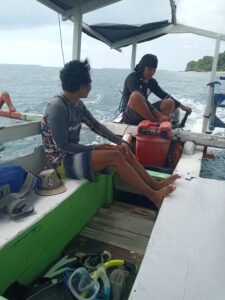

If you want excitement and a partying vibe, then I would proceed directly to the three Gili Islands: Trawangan, Meno, and Air. These islands are situated off the Northwestern tip of Lombok. There are a multitude of ways to get to Gili. Using my hotel concierge services, I chose to hire a traditional Indonesian boat called a Jukung and its crew of two sailors for my journey. During my day trip to Gili, I was also able to go snorkeling in the clear waters off the coast of Gili Meno to view colorful marine life close-up, which was definitely a memorable experience.

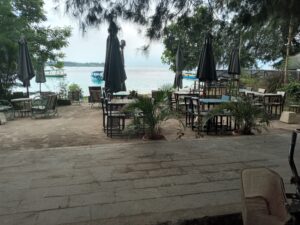
We also visited two of the three islands. First, we stopped at Trawangan, the hopping tourist spot loaded with bars and nightclubs. I visited Gili during the height of the pandemic when international tourism was halted, so Trawangan was almost abandoned, but I could see that during normal times the island was filled with tourist traps like Irish Pubs and Karaoke Bars—it’s like a slice of tourist-Bali had been uprooted and transported to Trawangan. Motorized vehicles are not allowed on the islands; instead, you can walk or ride on one of the ubiquitous horse-drawn carts, which are primarily found on Trawangan.
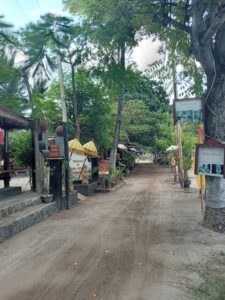
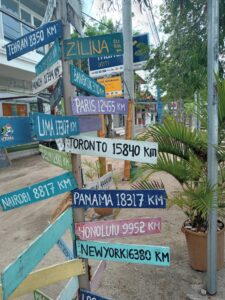
I much preferred the second island I visited named Meno. It was very rustic, and its touristic amenities (inns and restaurants) blended into the landscape of the island much more naturally than on Trawangan. This calm and laid-back island would be the place I would choose to stay if I were ever to return as I can visit Irish pubs in Ireland or Boston. Regardless, whether you take a day trip to Gili like I did, or have the islands serve as your ultimate tropical getaway for a few days, I would recommend making a visit if you are in Lombok.
Patuh Weaving Cooperative
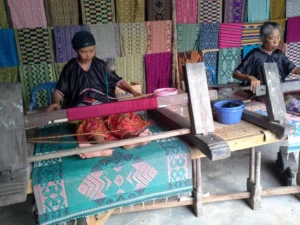
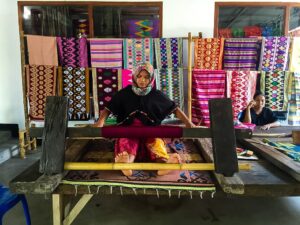
It takes about an hour to travel from the northern part of Lombok to the airport in the south. I departed my hotel for the return flight to Jakarta a bit too early, so my driver suggested we stop at the Patuh Weaving Cooperative on the way there, as the Cooperative is only ten minutes from the airport. I was very grateful for the driver’s suggestion because I was able to witness several of the weavers in action and I was able to purchase a few lovely, hand-woven souvenirs. It’s a great final stop for your Lombok visit.
